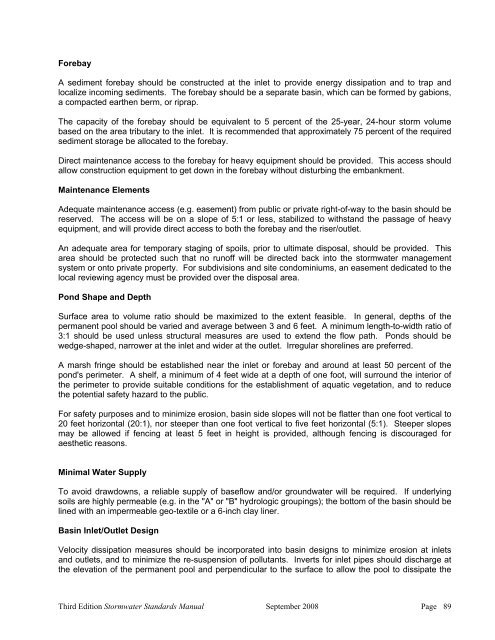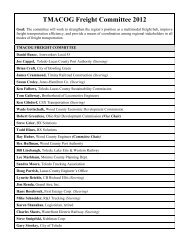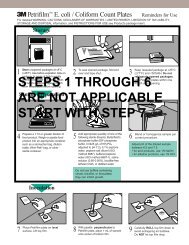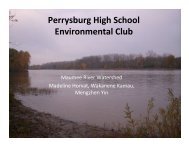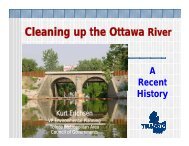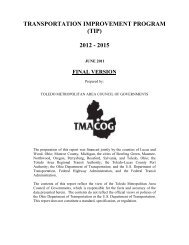Stormwater Management Standards Manual - Toledo Metropolitan ...
Stormwater Management Standards Manual - Toledo Metropolitan ...
Stormwater Management Standards Manual - Toledo Metropolitan ...
Create successful ePaper yourself
Turn your PDF publications into a flip-book with our unique Google optimized e-Paper software.
Forebay<br />
A sediment forebay should be constructed at the inlet to provide energy dissipation and to trap and<br />
localize incoming sediments. The forebay should be a separate basin, which can be formed by gabions,<br />
a compacted earthen berm, or riprap.<br />
The capacity of the forebay should be equivalent to 5 percent of the 25-year, 24-hour storm volume<br />
based on the area tributary to the inlet. It is recommended that approximately 75 percent of the required<br />
sediment storage be allocated to the forebay.<br />
Direct maintenance access to the forebay for heavy equipment should be provided. This access should<br />
allow construction equipment to get down in the forebay without disturbing the embankment.<br />
Maintenance Elements<br />
Adequate maintenance access (e.g. easement) from public or private right-of-way to the basin should be<br />
reserved. The access will be on a slope of 5:1 or less, stabilized to withstand the passage of heavy<br />
equipment, and will provide direct access to both the forebay and the riser/outlet.<br />
An adequate area for temporary staging of spoils, prior to ultimate disposal, should be provided. This<br />
area should be protected such that no runoff will be directed back into the stormwater management<br />
system or onto private property. For subdivisions and site condominiums, an easement dedicated to the<br />
local reviewing agency must be provided over the disposal area.<br />
Pond Shape and Depth<br />
Surface area to volume ratio should be maximized to the extent feasible. In general, depths of the<br />
permanent pool should be varied and average between 3 and 6 feet. A minimum length-to-width ratio of<br />
3:1 should be used unless structural measures are used to extend the flow path. Ponds should be<br />
wedge-shaped, narrower at the inlet and wider at the outlet. Irregular shorelines are preferred.<br />
A marsh fringe should be established near the inlet or forebay and around at least 50 percent of the<br />
pond's perimeter. A shelf, a minimum of 4 feet wide at a depth of one foot, will surround the interior of<br />
the perimeter to provide suitable conditions for the establishment of aquatic vegetation, and to reduce<br />
the potential safety hazard to the public.<br />
For safety purposes and to minimize erosion, basin side slopes will not be flatter than one foot vertical to<br />
20 feet horizontal (20:1), nor steeper than one foot vertical to five feet horizontal (5:1). Steeper slopes<br />
may be allowed if fencing at least 5 feet in height is provided, although fencing is discouraged for<br />
aesthetic reasons.<br />
Minimal Water Supply<br />
To avoid drawdowns, a reliable supply of baseflow and/or groundwater will be required. If underlying<br />
soils are highly permeable (e.g. in the "A" or "B" hydrologic groupings); the bottom of the basin should be<br />
lined with an impermeable geo-textile or a 6-inch clay liner.<br />
Basin Inlet/Outlet Design<br />
Velocity dissipation measures should be incorporated into basin designs to minimize erosion at inlets<br />
and outlets, and to minimize the re-suspension of pollutants. Inverts for inlet pipes should discharge at<br />
the elevation of the permanent pool and perpendicular to the surface to allow the pool to dissipate the<br />
Third Edition <strong>Stormwater</strong> <strong>Standards</strong> <strong>Manual</strong> September 2008 Page 89


